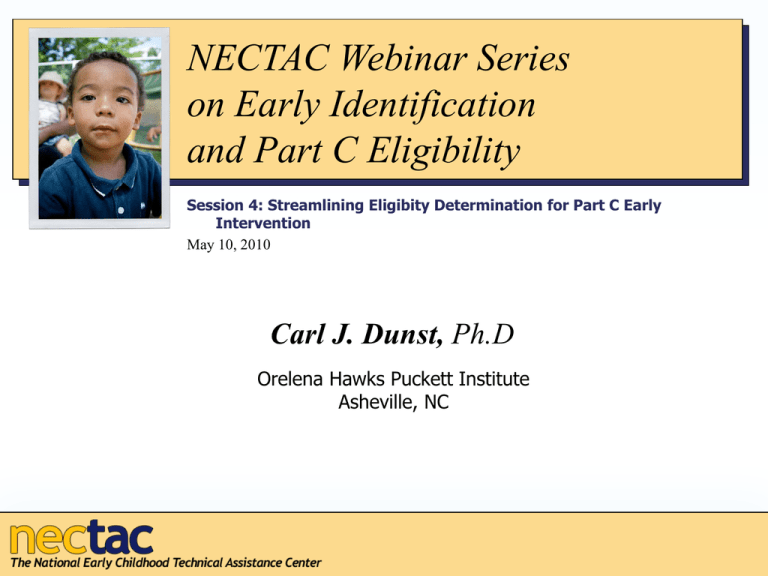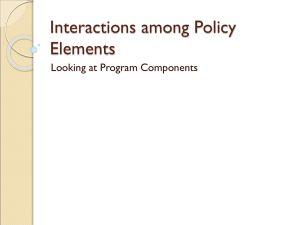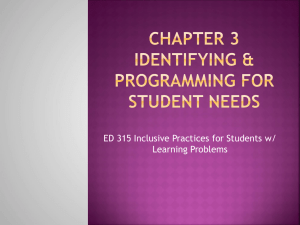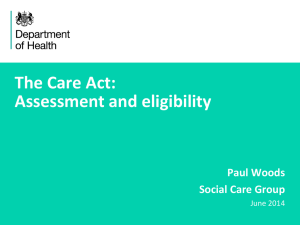Streamlining Eligibility Determination for Part C Early Intervention
advertisement

NECTAC Webinar Series on Early Identification and Part C Eligibility Session 4: Streamlining Eligibity Determination for Part C Early Intervention May 10, 2010 Carl J. Dunst, Ph.D Orelena Hawks Puckett Institute Asheville, NC Purposes • Clarify the meaning of the categories of infants and toddlers who are eligible for Part C early intervention • Describe the procedures for developing guidelines for simplifying eligibility determination for participation in Part C early intervention Placing the Streaming Process in Perspective (A short history of eligibility determination) United States of America Committee on Education and Labor Congressional Report 99-860 Education of the Handicapped Act Amendments of 1986 Definition of the term “Handicapped Infants and Toddlers” 1. Experiencing developmental delays, as measured by appropriate diagnostic instruments and procedures…or 2. have a diagnosed physical or mental condition which has a high probability of resulting in a developmental delay (emphasis added) (e.g., a child with Down Syndrome is de facto eligible) Congressional Report 99-860 Meaning of Term “Diagnosed Physical and Mental Condition” A condition which has a high probability of resulting in a developmental delay [and includes] infants and toddlers who will need early intervention services even though many will not exhibit developmental delays at the time of diagnosis (emphasis added) The term [diagnosed physical and mental condition] may also include at a State’s discretion…infants and toddlers who are “at risk” of having substantial developmental delays if early intervention services are not provided (emphasis added) Individuals with Disabilities Education Improvement Act of 2004 Public Law 108-446 An infant or toddler with a disability means an individual who: (A)(i) is experiencing developmental delays as measured by appropriate diagnostic instruments and procedures, (A)(ii) has a physical or mental condition that has a high probability of resulting in developmental delays, and (B)(i) at risk infants and toddlers who may experience a substantial developmental delay if early intervention were not provided Tracking, Referral and Assessment Center for Excellence (TRACE) I want to take the information about eligibility and describe the development of an eligibility determination process that attempts to streamline eligibility decisions. Decision Making Algorithms An algorithm is a step-by-step decision-making process that results in an accurate decision in as few steps as possible The more straightforward the decision making process, the higher the probability that accurate decisions will be made An Eligibility Determination Algorithm The eligibility criteria for Part C early intervention were used to develop a decision-making process that could facilitate and streamline infants and toddlers enrollment in early intervention. Decision Rules 1. If a child has an identified condition or diagnosis that has a high probability of resulting in a developmental delay and the condition or diagnosis is included in the State’s eligibility definition, then the child is eligible for early intervention. 2. If a child has one or more biological at-risk conditions and any of these conditions are included in the State’s eligibility criteria, then the child is eligible for Part C early intervention. 3. If a child has one or more environmental risk conditions and the number of conditions a child is experiencing meets the State’s eligibility criteria, then the child is eligible for early intervention. 4. If the child has no identified condition or diagnosis and no biological or environmental risk factors but has a developmental delay and the degree of the delay meets a State’s eligibility criteria, then the child is eligible for early intervention. 5. If the child does not meet any of the above conditions but informed clinical opinion indicates that the child has an obvious need, then the child may be considered eligible for early intervention. Eligibility Determination Decision Algorithm Relationship Between Federal and State Eligibility Criteria Federal Criteria State Criteria Does the child have an identified condition? Is the condition included in the State’s Eligibility Definition? Step 1 Yes No No to Step 2 Yes Child is Eligible for Early Intervention Relationship Between Federal and State Eligibility Criteria Federal Criteria State Criteria Does the child have a biological risk condition? Is the biological risk condition included in the State’s Eligibility Definition? Step 2 Yes No No to Step 3 Yes Child is Eligible for Early Intervention Relationship Between Federal and State Eligibility Criteria Federal Criteria State Criteria Does the child experiencing environmental risk factors? Are the environmental risk factors included in the State’s Eligibility Definition? Step 3 Yes No No to Step 4 Yes Child is Eligible for Early Intervention Relationship Between Federal and State Eligibility Criteria Federal Criteria State Criteria Step 4 Does the child have an established developmental delay? Yes No No to Step 5 Does the degree of delay meet the State’s Eligibility Definition? Yes Child is Eligible for Early Intervention Relationship Between Federal and State Eligibility Criteria Federal Criteria State Criteria Step 5 Is there a developmental concern that warrants intervention? No Yes Child is not eligible for early intervention Is early intervention warranted based on clinical opinion? No Yes Child is Eligible for Early Intervention Field-Test of the Algorithm As part of research at TRACE, we used the eligibility determination algorithm on a sample of 180 infants and toddlers to determine the usability of the decision making process.ª Results showed that the decision-making process correctly identified eligible children at a 95+% accuracy rate. ª Mott, D.W., & Dunst, C.J. (2006). Use of presumptive eligibility for enrolling children in Part C early intervention. Journal of Early Intervention, 29, 22-31. What is Needed to Use the Algorithm? • An operational definition of developmental delay, explicit procedures for administering and scoring a developmental scale or instrument, and clearly defined steps for determining if a child’s developmental standing meets a State’s definition of delay. • A list of identified conditions that without exception make a child eligible for early intervention. • If included in a State’s eligibility definition, a list of risk factors and the particular number or constellation of factors that make a child eligible for early intervention. • Clearly stated guidelines and procedures for making a child eligible for early intervention using informed clinical opinion. State of the States • Most States and Jurisdictions (N= 47) do not serve at-risk infants and toddlers • The level of developmental delay necessary to be eligible for early intervention has become increasingly more stringent • The identified conditions that make a child eligible for early intervention are in some cases not as explicit as necessary and in other cases are not known by providers at the streetlevel • Procedures for using informed clinical opinion are more often than not vague and difficult to understand Conclusion One of the conclusions of the President’s Commission on Special Education (2001) was that “IDEA establishes complex requirements that are difficult to effectively implement at the state and local level. Nowhere in IDEA is this more complex than the eligibility determination process.” Add to this the cumbersome and complex procedures states have in the past and continue to develop, and the complexity is compounded. Eligibility determination need not be a cumbersome process, and methods like and eligibility determination algorithm could streamline infant and toddler enrollment in early intervention and ensure the timely provision of early intervention supports. NECTAC Webinar Series on Early Identification and Part C Eligibility Session 4: Streamlining Eligibility Determinations for Part C Early Intervention May 10, 2010 Thank you for listening. Presentations from this series and their related resources are made available on the NECTAC Web Site at: http://www.nectac.org/~calls/2010/earlypartc/earlypartc.asp





